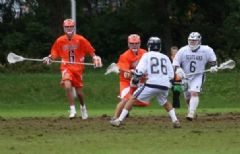These days, the anterior cruciate ligament (ACL) reconstruction is an extremely common operation. Varma quoted in Freddie Fu's book, "Current Concepts in ACL Reconstruction" (published in 2008), that over 95,000 ACL injuries occur each year in the United States alone, with in excess of 50,000 subsequent reconstructive surgeries being performed. In addition, the quantity of published articles focussing on the surgery & sports physiotherapy in relation to these injuries is vast.
So why is it, that so many operations are poorly performed (in this case the tourniquet was applied in a manner that has caused sustained damage), or even when performed to a high standard, the rehabilitation fails to make the most out of the surgical results?
Recently, my friend, & long-term contributor to www.OliverFinlay.com, John Geist, attended a conference on ACL injuries, post-operative rehabilitation & recurrence at University of Pittsburgh Medical Center (UPMC). John works here but it also happens to be the residence of renowned knee surgeon, Freddie Fu, so you can expect the team of therapists working in the practice should have a good grasp of the rehabilitation of these injuries.
Of the material that John reviewed & sent across to me, the protocols & tests that the clinicians at UPMC use in the assessment & evaluation of progression of post-operative ACL reconstructions were probably the most useful when passing on advice to my team mate. To be honest, the tests aren't ground-breaking but they are objective, thorough & are perfect for guiding well-structured, well-reasoned pathways that support the planning necessary for sensible progression back to activity.
It's omissions in this area that I think lets many rehabilitation approaches down, with too many therapists relying on "couch-based" treatment as opposed to functional exercise-based therapy & not really understanding (or objectively testing) which criteria need to be reached before starting the next phase of the training.
Click on the links below & take the time to read through each document. If you go on to quote these tests & protocols, please be mindful to respect the work of the clinicians at UPMC & reference accordingly.
Please remember that the reconstruction protocol has been developed with the specific approaches of the UPMC surgeons in mind & so cannot be taken as gospel for time scales for all post-operative cases.
Rick Joreitz, physiotherapist & athletic trainer at UPMC & the Pittsburgh Penguins presented an explanation of the protocols & testing procedures, which you can read by clicking on the links below. Please also reference Rick's information appropriately.
Rick's colleague, James Irrgang, talked about the recurrence rate in post-ACL operative cases & also paid specific attention to the high rate of subsequent contralateral ACL injuries following operative intervention. Please click on the links below to read the presentation but again please be mindful to reference James, should you look to quote his work.
In fact Wright et al (2011) found that rupture of the contralateral ACL occurred almost twice as frequently as a rupture of the grafted joint. This again goes to show that the rehabilitation needs to be thoroughly planned to address the needs of the athletic body as a whole as opposed to just a single kinematic chain. A victim of statistics, my team mate falls into this category.
A study by Raschner et al (2012), published in this month's British Journal of Sports Medicine discussed the link between ACL injuries & physical fitness in young ski racers. The authors found that female racers were at greater risk from sustaining ACL injury in the experimental population but also that core strength is also a predominant critical factor in the same group.
Now, I'm not personally a fan of the term "core strength" but it does highlight the fact that the proximal control of both healthy athletes & athletes rehabilitating from ACL reconstructive surgery is vital in reducing the risk of this type of injury...but there are many other papers that have identified a similar link.
For example, Myer et al (2012) also highlighted the increased risk of ACL injury in the female athletic population & further constructed an algorithm that considered the neuromuscular components to such injury, including the influence on lateral sway. Meanwhile, an injury prevention programme by Roe & Pinczewski, based around pre-activity warm-up also highlights the importance of proximal control when performing skills biased towards distal function.
Obviously, this is just a tiny taster of all the research that is out there on ACL rehabilitation but it just goes to show that we really don't have an excuse as a profession to be short-changing patients & athletes when it comes to providing suitable post-operative or conservative treatment in this field.
Good luck for a swift & full recovery Fozzie!!!!!

